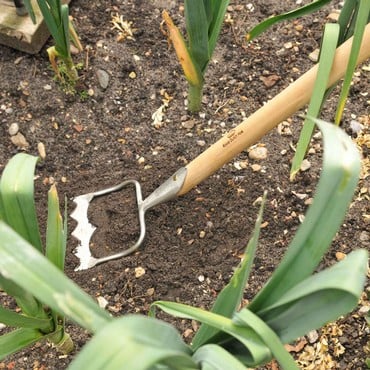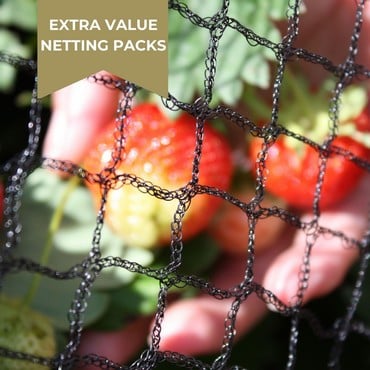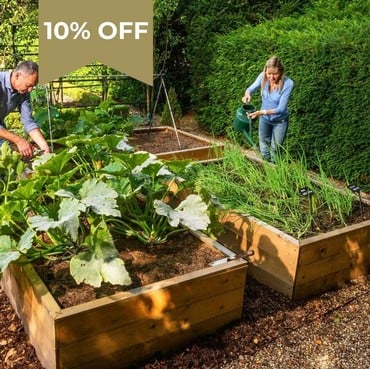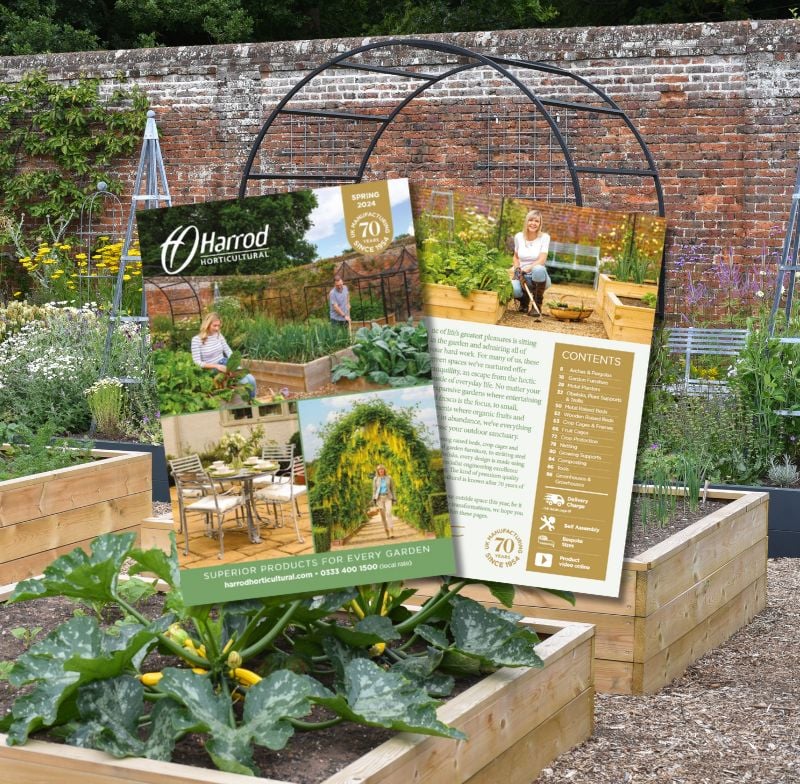May is always the busiest month in Stephanie’s Kitchen Garden, and sometimes I have to force myself to stop and just look at how beautiful it looks. The apple blossom on the espaliers is here for such a brief time, that it’s easy to miss it when you are focussed on the many jobs that need to be done. May, for me, is when the Kitchen Garden is at its most beautiful – full of lush green growth, blossom and the promise of what is to come.
This month we have been planting out all of the tender vegetables that have been enjoying life in the cold frame. May has seen some beautifully warm weather here in East Anglia, but we have also had some biting north winds and cold nights. We resisted the temptation to plant out our more tender crops to the middle of the month, still keeping cloches and fleece at the ready. Indeed, our courgettes are still covered with cloches waiting for the current cold spell to disappear. Along with courgettes, we’ve planted out sweetcorn, peas, runner beans, French beans, salads, and squashes. We are now at the stage where the garden is full and we have more plants than space!
May has been a very dry month on the eastern edge of the UK, so we have been watering all of our newly planted crops as well as 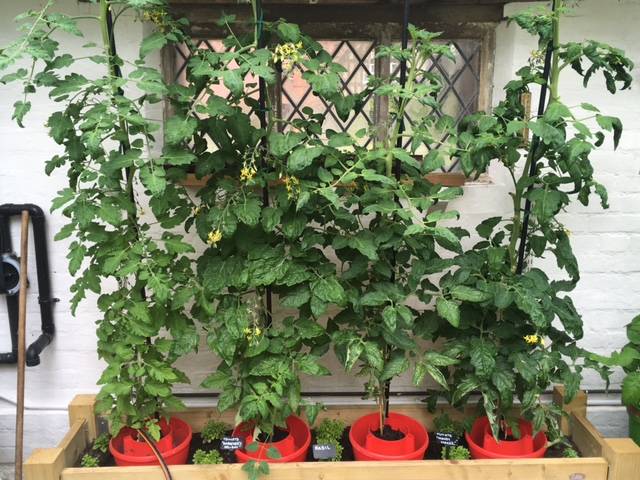 our raised beds and pots. Our water butts are now nearly empty and we could really do with some decent rainfall. With a Bank Holiday weekend ahead of us, I am sure this won’t be far away! I am always an advocate of growing plants hard, rather than spoiling them with too much ‘artifical’ rain. This encourages their roots to reach down to deeper water supplies in the soil rather than relying on surface water. For plants in the ground, such as brassicas and potatoes this will mean a thorough soaking once a week and only if no rain has fallen. Crops grown in raised beds will dry out a little quicker, but we add liners and mulch to help them cope on their own. However, in the early stages of their development, all our young plants will need watering to become established.
our raised beds and pots. Our water butts are now nearly empty and we could really do with some decent rainfall. With a Bank Holiday weekend ahead of us, I am sure this won’t be far away! I am always an advocate of growing plants hard, rather than spoiling them with too much ‘artifical’ rain. This encourages their roots to reach down to deeper water supplies in the soil rather than relying on surface water. For plants in the ground, such as brassicas and potatoes this will mean a thorough soaking once a week and only if no rain has fallen. Crops grown in raised beds will dry out a little quicker, but we add liners and mulch to help them cope on their own. However, in the early stages of their development, all our young plants will need watering to become established.
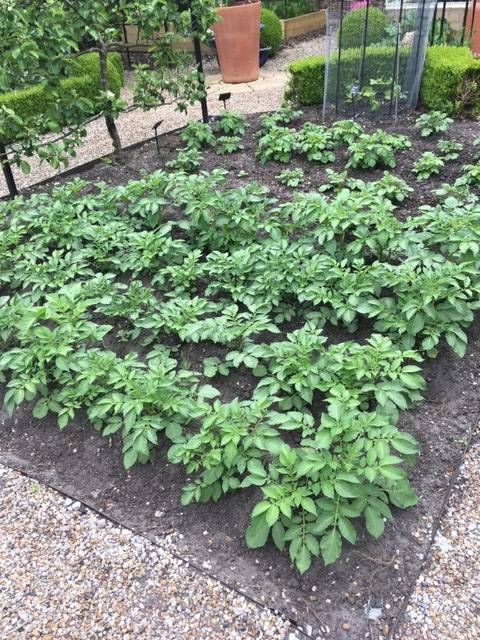 Our early potatoes are now big plants and have been earthed up twice during the month. Our maincrops are now growing well and have had their first earthing up. It won’t be long before they need doing again. Before planting, the ground had manure added to ensure it had enough fertility to keep potato plants happy. We will be adding a sprinkling of chicken manure pellets afer the final earthing up to give them an added boost.
Our early potatoes are now big plants and have been earthed up twice during the month. Our maincrops are now growing well and have had their first earthing up. It won’t be long before they need doing again. Before planting, the ground had manure added to ensure it had enough fertility to keep potato plants happy. We will be adding a sprinkling of chicken manure pellets afer the final earthing up to give them an added boost.
Healthy plants will resist pests and diseases much better than those grown under stress, so it’s important to adopt a good feeding regime to keep crops happy. Leafy vegetables, such as brassicas are treated to a top dressing of fish, blood and bone every six weeks. Fruiting vegetables such as courgettes and squash enjoy a drench of liquid seaweed feed once a week. In the greenhouse, tomatoes, peppers, aubergines and cucumbers are fed weekly with liquid tomato feed. Its also a good idea to get into the habit of checking over vegetable plants on a regular basis so that attacks from pests and diseases can be spotted early and dealt with quickly.
The major pest of the year so far in the Kitchen Garden would have to be the snail. Our slug population is kept under control with the regular application of nemaslug. This always works for us and, although we may occasionally spot a little tiny slug, they rarely cause us any concern. And whilst snails are always appearing, we usually manage to keep them at bay. This year, however, we are experiencing an invasion all around the garden. We have been out with buckets collecting them up after rainfall. In the Kitchen Garden, we have been using organic slug pelllets around most crops as the snails seem to be attacking plants left, right and centre. So far we seem to be winning the war, with damage kept to a minimum, but we won’t be resting on our laurels. We won’t know who has won until much later in the year!
We have yet to spot our first cabbage white butterfly, but our brassicas are already covered in netting to make sure we don’t 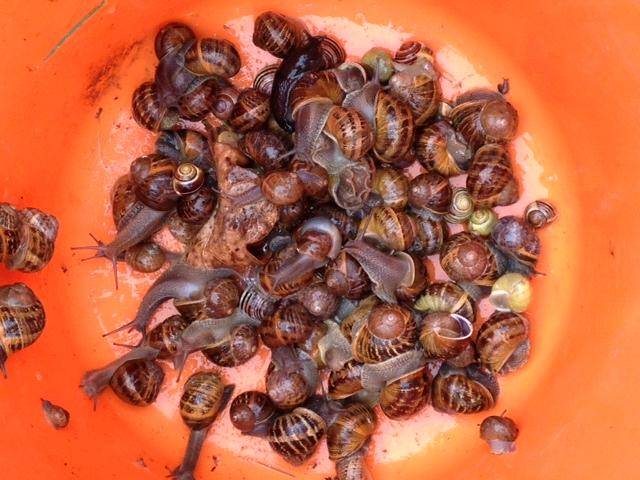 become victim to a caterpillar invasion. The birds are ever present in the trees around the garden, waiting for an easy meal. Our strawberries and blueberries have now been covered wth bird netting to avoid us losing any of our precious crop. Last year, mice destroyed our strawberry crop, so we have already placed traps around the strawberry bed to stop it from recurring this year.
become victim to a caterpillar invasion. The birds are ever present in the trees around the garden, waiting for an easy meal. Our strawberries and blueberries have now been covered wth bird netting to avoid us losing any of our precious crop. Last year, mice destroyed our strawberry crop, so we have already placed traps around the strawberry bed to stop it from recurring this year.
All around the garden, plants seem to be growing as we watch and getting taller by the day. We have been busy staking and tying in our peas, sweet peas, brussel sprouts and broad beans. In the greenhouse our tomatoes and cucumbers are scrambling up their supports and are regularly tied in. It’s also a good opportunity to check the tomatoes for side shoots that need pinching out. Our peppers and aubergines have now reached a height where support is necessary so they have also been staked to keep them stable.
As well as all the planting out, watering and feeding, we have also been busy with the hoe keeping on top of the weeds in all of our beds. The warm weather, combined with fertile soil and watering has benefited not only our crops, but the wretched weeds as well. They are popping up all over the place and it’s a good idea to attack them regularly with a hoe to stop them from becoming established. This is a job best done when the soil is dry and the sun is out. The weeds can be hoed off and left to die on the the surface of the soil. In wetter conditions we prefer to scratch them out and dispose of them in the compost bin.
The harvest has begun in force this month, with the first strawberries being picked in the greenhouse and the freezer packed with lovely rhubarb. We’ve also been harvesting salads for several weeks now. But for me, the highlight of May is always the first crop of asparagus. Being a seasonal crop, it’s a real treat and one of my favourites. So far we are picking a lot of fat healthy spears so I’m hoping it will be a bumper year.
Here are some of the jobs we've got planned for June in Stephanie's Kitchen Garden:
- Pinch out side shoots on tomatoes.
- Continue sowing and pricking out seeds.
- Continue weekly feed of all crops.
- Put up wasp traps in fruit trees.
We're always here to offer help and support. Go to the Ask the Expert section on our website and email Horticultural Advisor Jo Blackwell with your Kitchen Garden and she'll do her best to help.
We're busy tweeting about all things Harrod Horticultural - what we're doing, special offers, gardening tips and advice and you can always use Twitter or Facebook to get in touch with us as well. With our webteam manning the Tweet desks and Facebook site, you can be sure you will get the best service we can offer.
Our 108 page Summer catalogue is out now and is packed full of gardening ideas and products to solve the problems every gardener faces, plus plenty more seasonal ideas for harvesting, storage and preserving solutions.
Happy gardening!

















